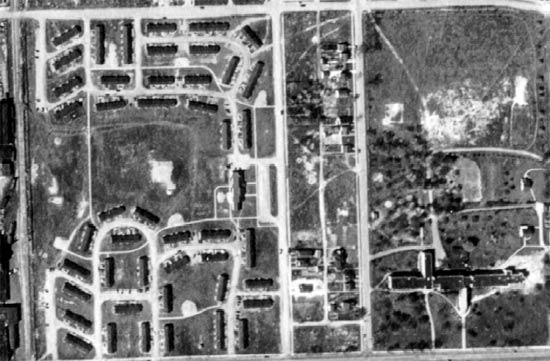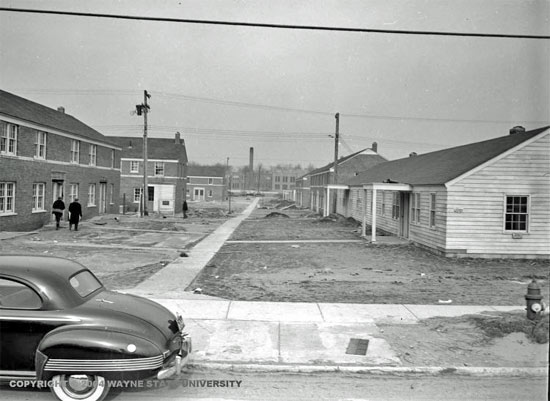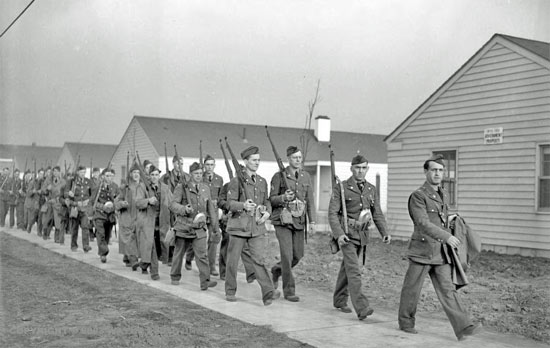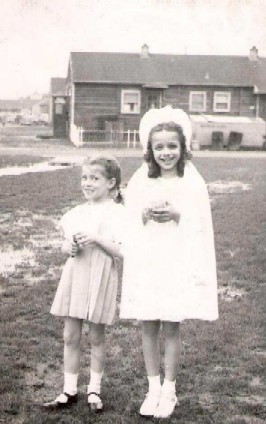Mommydearest Member Username: Mommydearest Post Number: 1 Registered: 08-2007 |
Does anyone know the name of this housing project that was built during World War II for, I believe, defense workers? I lived there as a young child and attended St. Louis the King school, first going to Von Steuben for kindergarten. I know it has been torn down but don't know when. Interested in finding any photographs of that housing project. | ||
Gary Member Username: Gary Post Number: 229 Registered: 02-2004 |
I believe it was the Sojourner Truth Homes. Also the scene of an ugly confrontation when neighborhood residents objected to Black families moving in. | ||
Pam Member Username: Pam Post Number: 2233 Registered: 11-2005 |
http://detroit1701.org/Sojourn er%20Truth%20Housing%20Project .html | ||
Mommydearest Member Username: Mommydearest Post Number: 2 Registered: 08-2007 |
I think, but I'm not certain, that the Sojourner Truth Homes were further west of this project. These homes were between Nevada and Hildale, with the western border being the railroad tracks and the eastern border Sherwood Street. I recall that the majority of the residents were white and a lot of them were from the south and all worked in manufacturing plants of some sort. They were wood barracks and were attached to each other in a row. | ||
Hornwrecker Member Username: Hornwrecker Post Number: 1863 Registered: 04-2005 |
Have a look at this archived thread about WWII era temporary housing on the Eastside: https://www.atdetroit.net/forum/mes sages/62684/73103.html ... and look at my post #1203, about 2/3s of the way down. | ||
Mommydearest Member Username: Mommydearest Post Number: 3 Registered: 08-2007 |
Thanks, Hornwrecker. Mikem's posts #2547 and 2550 show an example of the wooden row houses that were typical and aerial shots of the housing I was looking for on the north side of Nevada with the Lutheran School for the Deaf to the east. I remember playing with children from the school and learning to communicate with them and as a child aspiring to become a speech teacher. Sadly, that never happened. I still don't know the name of this particular housing project but recall that it was a mix of people from across the country and we all got along and played with each other. I attended the local Polish Catholic School, St. Louis the King, and have many fond memories up until 1949 when we moved to Dearborn. Life was certainly a lot simpler in that time. Thanks for your help. | ||
Concon Member Username: Concon Post Number: 19 Registered: 04-2007 |
All: To the best of my knowledge, the the Sojourner Truth Homes has NOT been torn down. It is not within the purview of this book to discuss the ramifications of the race riots of 1943 in Detroit. But the efforts by Senator Stanley Nowak to ameliorate the racial tensions have never been recorded by black writers as well as his contribution to civil rights and the Civil Rights commission. Most authorities stated that Polish Americans were not distinguishable in participating in the war time riots. "More often, observers referred to Polish Catholics, who contested blacks for the Sojourner Truth Homes and several neighborhoods east of the ghetto, immediately north and south of Hamtramck-itself an "anti-Negro" enclave. Nevertheless, except for minor skirmishes and a few arrests in Hamtramck, Poles did not stand out in the minds of onlookers as rioters." Of Polish extraction, the author cannot refrain from his sympathy with the Polish view of okolica and the drive of Polish Americans to protect their most valuable asset, their homes, so he presents in the spirit of academic discussion, Auditur et altera pars (Let the other side be heard). The Polish side constitutes an apologia, not either an evangelization or expectation to convince the readers of Polonia’s position. Moreover, Professor David R. Roediger, as many other authorities, have documented the above average ownership of single family homes by Polish Americans and their pride in home ownership. Vernon Jarrett stated, “I presume that the worst attacks on Eleanor Roosevelt came in the wake of the Detroit riots, beginning in 1942 and culminating in that awful scene in 1943. Eleanor Roosevelt had urged the introduction of blacks into the Sojourner Truth Housing Project in Detroit. Now incidentally, the housing project was named after an African American heroine, Sojourner Truth. Well, they went about doing it. There was great opposition, keep in mind, great opposition within Franklin Roosevelt's Administration. All of this was not just outside. It reached a point that, at one time, she referred to one of his aides as a fascist. That's how strongly she felt. And they were always advisors cautioning him about going too far. “Hold back.” While indirectly related, the location of the Sojourner Truth Housing Project produced opposition from Polonians in the area. Sojourner Truth Homes was located on a site federal authorities designated as “mixed,” but in fact, it was predominately “white,” if Polish Americans were to be regarded as Caucasians. It was situated near an ethnic Polish neighborhood, in the vicinity of incomplete Pershing High School (no auditorium, no gymnasium, no swimming pool unlike Denby High built a year later) on Detroit’s east side, 7 Mile Rd-Fenelon-Ryan area. As to the problems at Sojourner Project, no one can defend discrimination. However, reactions do not occur in a vacuum and all sides to the issue must be aired for a complete picture to be rationally considered. Generally, there is always another perspective, whether acceptable or not, in any conflict. The Polish Americans were protecting the only asset that they had been able to accumulate through years of hard labor, generally their sole asset, namely their home, their castle. They felt victimized by the federal government for not locating the project near Grosse Pointe or in other affluent areas, like Bloomfield Hills or Birmingham. Again, the white power structure placed the two lowest economic groups competing against each other. In effect, the Polish Americans felt that the federal government was discriminating against them. Where was the justice? Probably, because so few reside in Grosse Pointe Detroiters have practically no contact with them, their attitudes remain generally unknown, despite publications. Grosse Pointers don’t like Detroit, “It’s such an ugly city,” one woman said. “The community is nervous about Negroes,” concluded America’s foremost social observer. As Prof. Thaddeus Radzialowski stated, historically, “In a few older areas of the city Blacks and Poles shared the same very poor neighborhoods without friction. For the most part, however, the incoming Poles did not move wholesale into old neighborhoods abandoned by earlier immigrants but created new ones around their new churches in farmland on the eastern and western edges of the rapidly expanding city.” And Dr. Thomas Sugrue concluded, "Detroit was, above all, a city of homes. … city residents had spent a large art of their life savings to buy a home, and they usually had little else to show for their work. ... Immigrants and their descendants believed that a home and property provided the very definition of a family. They placed enormous value on the household as the repository of family values and the center of community life." Below Professor James Pula discussed the Polish concept of okolica. "Unlike Protestant and Jewish places of worship, Catholic parishes were 'immovable.' When Jews and Protestants left urban areas, their synagogues and churches moved as well. Catholics invested heavily in their communities. 'Working-class immigrants were often more likely than middle-class Americans to own their own homes, McGreevy writes. Attachment to those parishes kept many Catholics in Northern cities as Protestants and Jews moved to the suburbs after World War II. Catholics had much more at stake in maintaining the urban status quo than those who had gone elsewhere. The history of the bitter urban conflict between African Americans and Irish Americans is striking in light of the parallels between the two cultures." However, "For generations, these Catholics, as throughout the country, had absorbed a gospel linking neighborhood, family, and parish." In defense of the Polish Americans, Professor James Pula recounted their historical and cultural past emphasizing their "values of nationalism, religion, property and community." In the attempt to realize these values, Pula documented the discrimination by various sources against the Poles. "As in Poland, the parish was the core of the Polish community in America. Thus to the Poles, home ownership was a very important cultural value. And, in America the most important unit of social identification, beyond the family, was the okolica, or neighborhood. More often than not, one's job, social activities, school, and virtually all other facets of life took place within the confines of this urban okolica.” The white ethnics argued, "tax monies raised from White working-class ethnics were used to purchase and tear down whole blocks of traditionally white ethnic communities, replacing them with low income housing reserved for so-called 'non-White' minorities to the exclusion of low income Poles. The fact that Polish Americans sought to preserve the unique nature of their neighborhoods did not mean that they were racist." Radzialowski argued that, “the class and ethnic prejudice directed against the Polish community in Detroit was perhaps more intense and persistent than elsewhere and that fact markedly affected the Poles’ attitude toward their Black rivals.” He noted that “the depression and unionization were the central external events that affected them just as the various Polonias were making the transition from immigrant community to ethnic community. The depression hit Polish Americans harder than most other groups in American society, set them back in their struggle to achieve a minimum level of economic security and, in fact, for a time seemed to jeopardize almost all of their gains. …The Great Depression attacked two of the most important pillars of Polish American working-class life: a secure job and homestead.” Based upon their peasant background, Poles yearned for home ownership and a plot of land. Generally, they reached their American dream with owning their own home. Again, the root of the conflict between African Americans and Polish Americans involved: “… the real cause of the contention was rooted in the poverty and difficulties each faced and the scarcity of the resources for which they struggled … As the two largest and poorest ethnic groups in the city, Poles and Blacks found themselves pitted against each other in the neighborhoods as in the work place.” (emphasis added) The crisis developed when the city of Detroit with federal assistance decided to build desperately needed housing for Black working-class families. The site chosen for the project was next to the newest Polish neighborhood in Detroit. The intention of the planners has never been revealed but the result of the site choice was clear. It put the undesirable Blacks away from the higher prestige groups in the city and next to the only and less desirable Poles. In one of those unusual instances in which a Polish Catholic priest allowed his nationalistic feelings transcend his Christianity, Father Constantine Dziuk, pastor of St. Louis the King, participated in the drive to prevent blacks from living in the Sojourner Home Project. Overcome with hyperbole, Dr. Angela Dillard’s description did not fit by denouncing him as "a Polish Catholic version of Gerald Smith." Congressman Rudolph Tenerowicz, Italian-American realtor Joseph Buffa, and others really led the protest. Again, instead of working toward the harmonization of the lower classes, the White-Power-Establishment put them in competition and animosity. "Citing the damage to property values (which was true) and fear for the safety of 'our white girls,' a white citizen's association - the Fenelon-Seven Mile Road Development Association - was formed." Professor Radzialowski concluded: “The Sojourner Truth riot was one of the first and in many ways the prototype of the postwar confrontations over housing that masked accumulated anger over an incessant job rivalry in a condition of always looming unemployment. It was also the product of aggression born of long yeas of contempt and discrimination by the dominant groups in the United States. The Poles and Black living in the same areas and working at the same jobs found each other the handiest and safest targets for venting frustration.” (emphasis added) Clearly, the competition for jobs underlay the struggle between the groups in the lower economic class, i.e. the blacks and the Polish Americans. Dr. E. Michael Jones defended Rev. Dziuk and the Poles in his The Slaughter of Cities: Urban Renewal as Ethnic Cleansing by indicating that alternative sites were not seriously considered to avoid the ethnic tensions. Demonizing any form of social engineering, Jones was highly critical of Detroit’s 1947 Master Plan, the city planners, Mayor Jerry Cavanaugh and the federal government while ignoring the real estate profiteers. The public may have been shocked to discover that agents of the Office of War Information and the Army’s G-2 kept constant surveillance over the inhabitants and filed detailed reports. | ||
Mikem Member Username: Mikem Post Number: 3422 Registered: 10-2003 |
I can't read that until you add some breaks between paragraphs. Mommydearest, I don't know if these temporary housing complexes had names like public housing projects did. Do you remember what your address was? Did the streets and courts have individual names, or was your address a Nevada address, with a building and apartment number? | ||
Trying_2_stay Member Username: Trying_2_stay Post Number: 29 Registered: 08-2007 |
Mommydearest I went to Von Steuben for middle school and that is no where near Sojourner Truth homes. Unless Von Steuben was moved, its address is 12300 Linnhurst St. This Von Steuben school is back behind Osborn High School on the east side not the northeast side. Krainz Woods stretches from 7 Mile Road and Ryan Road to 7 Mile and Mound Road. The Sojourner Truth Homes housing project is located there. The neighborhood was named after Captain John Krainz, a World War II hero from Detroit. (Message edited by Trying_2_stay on August 12, 2007) | ||
Mommydearest Member Username: Mommydearest Post Number: 4 Registered: 08-2007 |
Mikem: The address was 6505 East Nevada, no building number that I recall, but I was pretty young at the time. The last time I was there that address was the headquarter of Frank's Nursery (now out of business). I've attached the aerial photo you had uploaded previously showing the temporary housing at that address. Trying_2_stay: I made an error - it was my sister who attended Von Steuben when we lived on Alcoy before moving to the temporary housing.  | ||
Mikem Member Username: Mikem Post Number: 3431 Registered: 10-2003 |
Thanks Mdearest. Looks like a dozen or so buildings on the courts off of Nevada where you lived. I was wondering how they got your mail to you. Like I said on the previous thread, the city constructed over 6,000 of these and I doubt any were named complexes. A couple of pictures of the Sojourner Truth complex show some of the temporary wooden structures around the perimeter of the site. Do these trigger any memories?   Many thanks to the VMC at WSU. | ||
Mommydearest Member Username: Mommydearest Post Number: 5 Registered: 08-2007 |
No Mikem, they don't trigger any memories, and in fact they appear to be a lot nicer construction than the ones we lived in. The aerial photo did trigger memories of all of us kids playing in the area between the homes on the south and the north end of the project and learning to roller skate on that long sidewalk between them. I also recall that there were drainage ditches that we used as swimming holes after a hard summer rain. Usually we were covered with grass clippings that were put there when the grass was cut. We spent many summer nights climbing onto the roof and laying on our backs looking at the stars. Simple things for simple times. The only bad memory was the winter my grandmother came to visit from Pennsylvania and saved all our lives by waking us up when she realized that something was wrong with the coal burner and that we were all being overcome by carbon monoxide. She was very happy to return to her home state. I think I have some photos that I can dig up that will show some of the housing and will upload them this week. I recall reading somewhere that the temporary housing was from Aladdin Homes here in Michigan. | ||
Mikem Member Username: Mikem Post Number: 3437 Registered: 10-2003 |
Please post pictures if you can. There seemed to be a variety of styles of defense housing in the area ranging from large Quonset huts to what look like fancy ice fishing shacks. A quick search on Aladdin Homes produced this list of war contracts: http://clarke.cmich.edu/aladdi n/ww2/contract1.htm | ||
Mikem Member Username: Mikem Post Number: 3438 Registered: 10-2003 |
This looks like several that appear around the city in other photographs: http://clarke.cmich.edu/aladdi n/ww2/1942prefab/aladdin7.htm | ||
Mommydearest Member Username: Mommydearest Post Number: 6 Registered: 08-2007 |
Taken around 1946 or 1947. The outside of these housing units was never painted.  I'm laughing at the room sizes in your last post. How did we ever live in such little spaces? | ||
Mikem Member Username: Mikem Post Number: 3439 Registered: 10-2003 |
With optimism that it would only get better? Yes, looks very much like the one in the last link. I drove around the area today, and I think I saw one that was converted into a garage/workshop on the corner of Sherwood & Hildale. Thanks for the photo. |